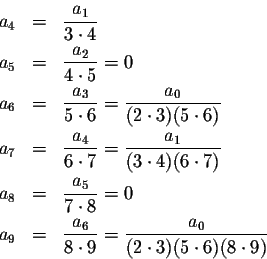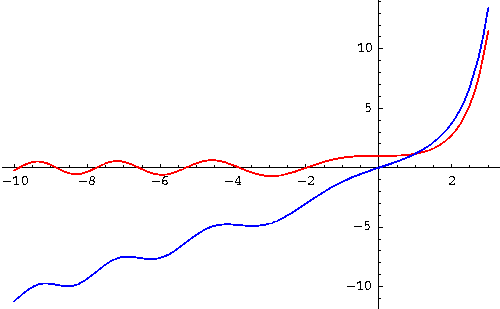

The general form of a homogeneous second order linear differential equation looks as follows:
The series solutions method is used primarily, when the coefficients p(t) or q(t) are non-constant.
One of the easiest examples of such a case is Airy's Equation
We want to find power series solutions for this second-order linear differential equation.
The generic form of a power series is

As in other techniques for solving differential equations, once we have a "guess" for the solutions, we plug it into the differential equation.
Recall that

Plugging this information into the differential equation we obtain:


Our next goal is to simplify this expression such that (basically) only one summation sign "![]() " remains. The obstacle we encounter is that the powers of both sums are different, tn-2 for the first sum and tn+1 for the second sum. We make them the same by shifting the index of the first sum up by 2 units and the index of the second sum down by one unit to obtain
" remains. The obstacle we encounter is that the powers of both sums are different, tn-2 for the first sum and tn+1 for the second sum. We make them the same by shifting the index of the first sum up by 2 units and the index of the second sum down by one unit to obtain

Now we run into the next problem: the second sum starts at n=1, while the first sum has one more term and starts at n=0. We split off the 0th term of the first sum:

Now we can combine the two sums as follows:


The power series on the left is identically equal to zero, consequently all of its coefficients are equal to 0:

We can slightly rewrite
as

We already know from the 0th recurrence relation that a2=0.
Let's compute a3 by reading off the recurrence relation for n=1:

The hardest part, as usual, is to recognize the patterns evolving; in this case we have to consider three cases:
1. All the terms
![]() are equal to zero. We can write this in compact form as
are equal to zero. We can write this in compact form as
2. All the terms
![]() are multiples of a0.
We can be more precise:
are multiples of a0.
We can be more precise:

3. All the terms
![]() are multiples of a1.
We can be more precise:
are multiples of a1.
We can be more precise:

Thus the general form of the solutions to Airy's Equation is given by

Note that, as always, y(0)=a0 and y'(0)=a1. Thus it is trivial to determine a0 and a1 when you want to solve an initial value problem.
In particular


Below you see a picture of these two solutions. Note that for negative t, the solutions behave somewhat like the oscillating solutions of y''+y=0, while for positive t, they behave somewhat like the exponential solutions of the differential equation y''-y=0.

|

